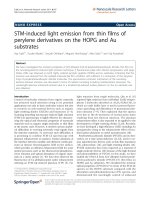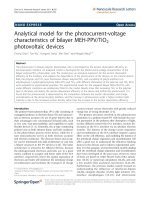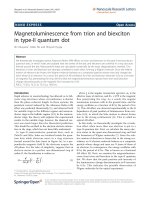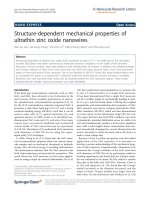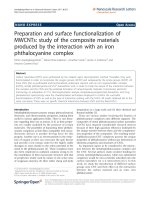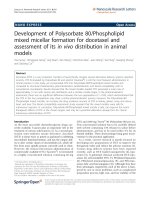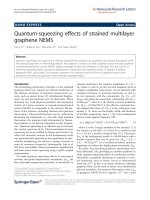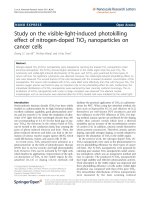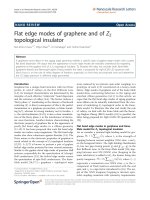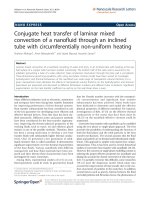Autio et al. EJNMMI Research 2011, 1:10 http://www.ejnmmires.com/content/1/1/10 ORIGINAL ppt
Bạn đang xem bản rút gọn của tài liệu. Xem và tải ngay bản đầy đủ của tài liệu tại đây (765.3 KB, 7 trang )
ORIGINAL RESEARCH Open Access
Mini-PEG spacering of VAP-1-targeting
68
Ga-DOTAVAP-P1 peptide improves PET imaging
of inflammation
Anu Autio
1
, Tiina Henttinen
2
, Henri J Sipilä
1
, Sirpa Jalkanen
3
and Anne Roivainen
1,4*
Abstract
Background: Vascular adhesion protein-1 (VAP-1) is an adhesion molecule that plays a key role in recruiting
leucocytes into sites of inflammation. We have previously shown that
68
Gallium-labelled VAP-1-targeting peptide
(
68
Ga-DOTAVAP-P1) is a positron emission tomography (PET) imaging agent, capable of visualising inflammation in
rats, but disadvantaged by its short metabolic half- life and rapid clearance. We hypothesised that prolonging the
metabolic half-life of
68
Ga-DOTAVAP-P1 could further improve its imaging characteristics. In this study, we
evaluated a new analogue of
68
Ga-DOTAVAP-P1 modified with a mini-polyethylene glycol (PEG) spacer (
68
Ga-
DOTAVAP-PEG-P1) for in vivo imaging of inflammation.
Methods: Whole-body distribution kinetics and visualisation of inflammation in a rat model by the peptide s
68
Ga-
DOTAVAP-P1 and
68
Ga-DOTAVAP-PEG-P1 were evaluated in vivo by dynamic PET imaging and ex vivo by measuring
the radioactivity of excised tissues. In addition, plasma samples were analysed by radio-HPLC for the in vivo stability
of the peptides.
Results: The peptide with the mini-PEG spacer showed slower renal excretion but similar liver uptake as the
original peptide. At 60 min after injection, the standardised uptake value of the inflammation site was 0.33 ± 0.07
for
68
Ga-DOTAVAP-P1 and 0.53 ± 0.01 for
68
Ga-DOTAVAP-PEG-P1 by PET. In addition, inflammation-to-muscle ratios
were 6.7 ± 1.3 and 7.3 ± 2.1 for
68
Ga-DOTAVAP-P1 and
68
Ga-DOTAVAP-PEG-P 1, respectively. The proportion of
unchanged peptide in circulation at 60 min after injection was significantly higher for
68
Ga-DOTAVAP-PEG-P1 (76%)
than for
68
Ga-DOTAVAP-P1 (19%).
Conclusion: The eight-carbon mini-PEG spacer prolonged the metabolic half-life of the
68
Ga-DOTAVAP-P1 peptide,
leading to higher target-to-background ratios and improved in vivo PET imaging of inflammation.
Keywords: gallium-68, inflammation imaging, mini-PEG spacer, positron emission tomography, vascular adhesion
protein-1
Background
In vivo imaging of inflammation is a demanding task,
and novel molecular imaging targets are called for. The
gold standard in nuclear medicine is the radiolabelling
of white blood cells, which is both time consuming and
potentially hazardous for the technical personnel.
Vascular adhesion protein-1 (VAP-1) is an inflamma-
tion-inducible endothelial adhesion protein involved in
the leucocyte trafficking from the blood stream into the
tissues. VAP-1 is stored in intracellular granules within
endothelial cells. However, upon inflammation, it is
rapidly translocated to the endothelial cell surface, for
example, in the synovial tissue in rheumatoid arthritis
andatthesiteofischemicreperfusioninjury[1,2].
Therefore, VAP-1 is both an optimal candidate for anti-
inflammatory therapy and a potential target for in vivo
imaging of inflammation. This approach may open new
opportunities for diagnosing, therapy planning and mon-
itoring of the treatment efficacy, as well as for the drug
discovery and development processes [3-6].
* Correspondence:
1
Turku PET Centre, University of Turku and Turku University Hospital, Turku,
Finland
Full list of author information is available at the end of the article
Autio et al. EJNMMI Research 2011, 1:10
/>© 2011 Autio et al; licensee Springer. This is an Open Access article distributed under the terms of the Creative Commons Attribution
License ( which permits unrestricted use, distribution, and reproduction in any medium,
provided the original work is properly cited.
Peptide-based imaging agents ar e small molecules that
possess favoura ble properties such as rapid diffusion in
target tissue, rapid clearance from the blood circulation
and non-target tissues, easy and low-cost synthesis, and
low toxicity and immunogenicity. We are particularly
interested in dev eloping radiolabelled peptides for VAP-
1 targeting for the purposes of in vivo imaging of leuco-
cyte trafficking. The linear peptide, VAP-P1, has been
characterised by Yegutkin et al. and proven to bind the
enzymatic groove of VAP-1 and dose-dependently inhi-
bit VAP-1-dependent lymphocyte rolling and firm adhe-
sion to primary endothelial cells [7]. We have previously
shown that
68
Ga-labelled DOTA-conjugated VAP-P1
peptide (
68
Ga-DOTAVAP-P1) is able to delineate
inflammation in rats by a VAP-1-specific way using
positron emission tomography (PET) [8-10]. Disadvanta-
geously, the
68
Ga-DOTAVAP-P1 peptide has relatively
short plasma half-life and very r apid clearance by the
kidneys to the urine.
PEGylation, the process by which polyethylene glycol
(PEG) chains or its derivatives, e.g., mini-PEGs are
attached to a peptide, has been used for modifying the
properties of radiolabelled compounds, such as antibo-
dies and peptides, in order to improve their imaging
characteristics. The goal of PEGylation is mainly to
improve the tracer’s kinetics and distribution pattern by
increasing its metabolic half-life and by lowering its
non-specific bi nding. By increasing the molecular mass
of the peptide and by shielding it from proteolytic
enzymes, PEGylation may modify its b iodistribution and
pharmacokinetics [11]. Thus, the method could over-
come the above mentioned shortcoming s. However,
because PEGylation may also have unfavourable effects,
such as inhibition of receptor binding and reduction of
target-to-background ratio, its impact must be carefully
evaluated for a new peptide.
We hypothesised that prolonging the m etabolic half-
life of
68
Ga-DOTAVAP-P1 would further improve its
potential for in vivo imaging of inflammation. In this
study, we evaluated a new mini-PEG spacered analogue
of
68
Ga-DOTAVAP-P1 (
68
Ga-DOTAVAP-P EG-P1) for
in vivo PET imaging of inflammation.
Methods
68
Ga-DOTA-peptides
The DOTA-conjugated peptides were purchased from
Almac Science s (By Gladsmuir, Scotland, UK) , ABX
advanced biochemical compounds GmbH (Radeberg,
Germany) and NeoMPS (Strasbourg, France).
Linear 9-amino acid DOTA-chelated peptide
(GGGGKGGGG) with and without a PEG linker (8-
amino-3,6-diooxaoctanoyl, PEG derivative, MW 145.16
Da) between the DOTA and the N terminal amino acid
was labelled with
68
Ga as previously described [8], and
named as
68
Ga-DOTAVAP-P1 and
68
Ga-DOTAVAP-
PEG-P1. Briefly,
68
Ga was obtained in the form of
68
GaCl
3
from a
68
Ge/
68
Ga generator (Cyclotron Co.,
Obninsk, Russia) by elution with 0.1 M HCl. The
68
GaCl
3
eluate (500 μl) was mixed with sodium acetate
(18 mg; Sigma-Aldrich, Seelze, Germany) to give a pH
of approximately 5.5. Then, DOTA-peptide (35 nmol)
was added and the mixture was incubated at 100°C for
20 min. No further purification was needed.
The radiochemical purity was determined by reversed-
phase HPLC (μBondapak C18, 7.8 × 300 mm
2
,125Å,
10 μm; Waters Corporation, Milford, MA, USA). The
HPLC conditions for
68
Ga-DOTAVAP-P1 have been
described previously [9]. The HPLC conditions for
68
Ga-
DOTAVAP-PEG-P1 were sligh tly different and as fol-
lows: flow rate = 4 ml/min, l =215nm,A =2.5mM
trifluoroacetic acid, B = acetonitrile and C = 50 mM
phosphoric acid. Linear A/B/C gradient was 100/0/0 for
0 to 3 min, 40/60/0 for 3 to 9 min, and 0/0/100 for 9 to
16 min. The radio-HPLC system consisted of LaChrom
instruments (Hitachi; Merck, Darmstadt, Germany):
pump L7100, UV detector L-7400 and interface D-7000;
an on-line radioisotope detector (Radiomatic 150 TR,
Packard, Meriden, CT, USA); and a computerised data
acquisition system.
In vitro stability and solubility
The in vitro stability of the
68
Ga-labelled peptides was
evaluated in human and rat plasma. Several samples
were taken during the 4-h incubation period at 37°C.
Proteins from plasma samples were precipitated with
10% sulphosalicylic acid (1:1 v/v), centrifuged at 3,90 0 ×
g for 3 min at 4°C, and filtered through 0.45-μmMinis-
pike filter (Waters Corporation). The filtrate was ana-
lysed by radio-HPLC.
The octanol-water distribution coefficient, logD,of
the
68
Ga-DOTA-peptides was determined using the
following procedure. Approximately 5 kBq of
68
Ga-
labelled peptide in 500 μl of phosphate-buffered saline
(PBS, pH 7.4) was added to 500 μl of 1-octanol. After
the mixture had been vortexed for 3 min, it was centri-
fuged at 12,000 × g for 6 min, and 100-μl aliquots of
both layers were counted in a gamma counter (1480
Wizard 3″ Gamma Counter; EG&G Wallac, Turku,
Finland). The test was repeated three times. The logD
was calculated as = log10 (counts in octanol/counts in
PBS).
Animals
All animal experiments were approved by the Lab-Ani-
mal Care & Use Committee o f the State Provincial
Office of Southern Finland and carried out in compli-
ance with the Finnish laws relating to the c onduct of
animal experimentation.
Autio et al. EJNMMI Research 2011, 1:10
/>Page 2 of 7
Male Sprague-Dawley rats (n = 14) were purchased
fromHarlan,Horst,TheNetherlands.Twenty-four
hours before the PET studies, turpentine oil (Sigma-
Aldrich; 0.05 ml per rat) was injected subcutaneously
into their neck area in order to induce a sterile inflam-
mation [10]. Six rats were PET imaged and additional
eight animals were used for in vivo metabolite analyses.
PET imaging and ex vivo biodistribution
The whole-body distribution and kinetics of
68
Ga-
DOTAVAP-P1 (n =3)and
68
Ga-DOTAVAP-PEG-P1 (n
= 3) in rats harbour ing a sterile inflammation were stu-
died with a high-resolution research tomograph (Sie-
mens Medical Solutions, Knoxville, TN, USA). The rats
were anaesthetised with isoflurane (induction 3%, main-
tenance 2.2%). Two rats were imaged at the same time,
and they were kept on a warm pallet during the imaging
procedure. Following a 6-min transmission for attenua-
tion correction, the rats were intravenously (i.v.) injected
with
68
Ga-DOTAVAP-P1 (15.8 ± 3.0 MBq, 19.4 ± 0.0
μg, 19.6 ± 0.0 nmol) or with
68
Ga-DOTAVAP-PEG-P1
(17.7 ± 1.6 MBq, 21.0 ± 1.3 μg, 18.5 ± 1.1 nmol) as a
bolus via a tail vein using a 24-gauge cannula (BD Neo-
flon, Becton Dickinson Infusion Therapy AB, Helsing-
borg, Sweden). Dynamic imaging lasting for 60 min
started at the time of injection. The data acquired in list
mod e were iteratively reconstructed with a 3-D ordered
subsets expectation maximisation algorithm with 8 itera-
tions, 16 subsets and a 2-mm f ull-width at half-maxi-
mum post-filter into 5 × 60 s and 11 × 300 s frames.
Quantitative analyses were performed by drawing
regions of interest (ROI) on the inflammatory foci, mus-
cle (hind leg), heart, kidney, liver and urinary bladder.
Time-activity curves (TACs) were extracted from the
corresponding dynamic images (Vinci software, version
2.37; Max P lanck Institute for Neurological Research,
Cologne, Germany). The average radioactivity concen-
trations in the ROIs (kilobecquerels per millilitre) were
used for further analyses. The uptake was reported as
standardised uptake value (SUV), which was calculated
as the radioactivity of the ROI divided by the relative
injected radioactivity expressed per animal body weight.
The radioactivity remaining in the tail was compensated.
After the PET imaging, the animals were sacrificed.
Samples of blood, urine and various organs were col-
lected, weighed and measured for radioactivity using the
gamma counter (Wizard, EG&G Wallac). The results
were expressed as SUVs.
Blood analyses
Blood samples (0.2 ml of each) were drawn at 5, 10, 15,
30, 45, 60 and 1 20 min after injection of
68
Ga-DOTA-
peptides into heparinised tubes (Microvette 100; Sar-
stedt, Nümbrecht, Germany). Radioactivity of whole
blood was measured with the gamma counter (Wizard,
EG&G Wallac). Plasma was separated by centrifugation
(2,200 × g for 5 min at 4°C), and plasma radioactivity
was measured. The ratio of radioactivi ty in blood versus
plasma was calculated. To determine plasma protein
binding, proteins were precipitated with 10% sulphosa-
licylic acid, and the radioactivity in protein precipitate
and supernatant was measured. The plasma supernatant
was further analysed by radio-HPLC in order to evaluate
the in vivo stability of the
68
Ga-labelled peptides.
In vivo stability data were used in order to generate
metabolite-corrected plasma TACs for
68
Ga-DOTA-
VAP-P1 and
68
Ga-DOTAVAP-PEG-P1, which were
further used for the calc ulation of pharmacokinetic
parameters. The area under curve (AUC) of the plasma
TAC from 0 to infinity was calculated using a non-com-
partmental analysis employing the trapezoidal rule. The
clearance (CL) of the
68
Ga-labelled peptides after a sin-
gle intravenous bolus dose was calculated by dividing
the injected dose by the AUC. The plot of the natural
logarithm of parent tracer concentration against time
after bolus injection b ecame linear in the end phase, as
the tracer was eliminated according to the laws of first-
order reaction kinetics. The elimination rate constant
( k
el
) was calculated as the negative slope of the linear
part of the plot. The plasma elimination half-life (t
1/2
)
was calculated as t
1/2
=ln(2)/k
el
. The metabolic half-
lives of the
68
Ga-DOTA-peptides were calculated
according to the results of radio-HPLC, i.e. the time
point when 50% of the total radioact ivity is still bound
to the intact peptide.
Statistical analyses
All the results are express ed as means ± standard devia-
tion (SD) and range. The correlations between PET ima-
ging and ex vivo mea surement values were evaluated
using linear regression analysis. Inter-group comparisons
were made using an unpaired t test. Statistical analyses
were conducted using Origin 7.5 software (Microcal,
Northampton, MA, USA). A P value less than 0.05 was
considered as statistically significant.
Results
In vitro studies
The radiochemical purities of
68
Ga-DOTAVAP-P1 and
68
Ga-DOTAVAP-PEG-P1 were 97 ± 1% and 99 ± 1%,
and specific radioactivities 2.27 ± 0.47 and 2.55 ± 0.45
MBq/nmol, r espectively. The retention times for
68
Ga-
DOTAVAP-P1 and
68
Ga-DOTAVAP-PEG-P1 were 6.6
± 0.1 and 6.7 ± 0.1 min, respectively. The retention time
for free gallium was approximately 12 min, and it eluted
only with phosphoric acid. The in vitro stabilities of
68
Ga-DOTAVAP-P1 and
68
Ga-DOTAVAP-PEG-P1 were
very similar. The amounts of unchanged peptide after
Autio et al. EJNMMI Research 2011, 1:10
/>Page 3 of 7
the 4-h incubation in human or rat plasma were 88 ±
3% and 82 ± 11% for
68
Ga-DOTAVAP-P1 and 89 ± 8%
and 90 ± 6% for
68
Ga-DOTAVAP-PEG-P1, respectively.
Both peptides were highly hydrophilic; logD was -3.30
for
68
Ga-DOTAVAP-P1 and -3.50 for
68
Ga-DOTAVAP-
PEG-P1.
PET studies with rat model of inflammation
Both peptides were capable of visualising inflammatory
foci from surrounding tissues by PET imaging (Figure
1a). The inflammation uptakes expressed as SUVs were
0.33 ± 0.07 (range, 0.26 to 0.40) and 0.53 ± 0.01 (range,
0.42 to 0.60) for
68
Ga-DOTAVAP-P1 and
68
Ga-DOTA-
VAP-PEG-P1, respectively, at 60 min after injection.
Inflammation-to-muscle ratios at 60 min after injection
were6.7±1.3(range,5.2to7.5)and7.3±2.1(range,
5.6 to 9.7) for
68
Ga-DOTAVAP-P1 and
68
Ga-DOTA-
VAP-PEG-P1, respectively. The kinetics of
68
Ga-DOTA-
VAP-P1 and
68
Ga-DOTAVAP-PEG-P1 in i nflammatory
foci were quite fast, and the peak radioactivity was
reached w ithin 20 min for both peptides. On the aver-
age, the inflammation upt ake of
68
Ga-DOTAVAP-PEG-
P1 was 59% higher than that of
68
Ga-DOTAV AP-P1,
and the difference was statistically significant (P =
0.047). According to the whole-body dynamic PET ima-
ging,
68
Ga-DOTAVAP-PEG-P1 showed slower renal
excretion to urine but otherwise rather similar
distribution kinetics as the original peptide
68
Ga-DOTA-
VAP-P1 (Figure 1b, c, d, e).
The PET imaging results were verified by ex vivo mea-
surements (Figure 2). Linear regression analysis showed
reasonable correlation between in vivo PET and ex vivo
tissue samples (R =0.58,P = 0.0 23 for
68
Ga-DOTA-
VAP-P1 and R =0.80,P < 0.001 for
68
Ga-DOTAVAP-
PEG-P1). When the tissue uptakes of
68
Ga-DOTAVAP -
P1 and
68
Ga-DOTAVAP-PEG-P1 were compared, the
inflammation, lung, small intestine, skin and urinary
bladder radioactivities were significantly different.
Although the PET and ex vivo methods cor relate well,
there are some discrepancies between the results. For
example, in the PET image analysis, the urine and blood
of kidney are included in the “kidney” ROI, whereas for
ex vivo measurement, the excised tissue samples are
dotted dry on a paper. Since the radioactivity of urine is
extremely high, the in vivo kidney SUV is higher than
that of ex vivo.
The blood-plasma ratios and the plasma free fractions
(fp), i.e. the fraction of total radioactivity in plasma that
is unbound to plasma proteins, were 1.3 ± 0.1 and 0.84
±0.04for
68
Ga-DOTAVAP-P1 and 1.3 ± 0.1 and 0.86 ±
0.02 for
68
Ga-DOTAVAP-PEG-P1, respectively. The in
vivo stability of
68
Ga-DOTAVAP-PEG-P1 was better
than that of
68
Ga-DOTAVAP-P1. The proportions of
unchanged peptides in rat plasma at 60 and 120 min
Figure 1 PET images and time-activity curves.(a) Representative coron al PET images of Sprague-Dawley rats with sterile turpentine oil-
induced inflammation as a sum image of 10 to 60 min after i.v. injection of
68
Ga-DOTAVAP-P1 (13.8 MBq) or
68
Ga-DOTAVAP-PEG-P1 (17.5 MBq).
Time-activity curves of (b) inflammation and muscle, (c) kidney, (d) liver and (e) urinary bladder for
68
Ga-DOTAVAP-P1 and
68
Ga-DOTAVAP-PEG-
P1.
Autio et al. EJNMMI Research 2011, 1:10
/>Page 4 of 7
after injection were 19 ± 4% and 4 ± 1% for
68
Ga-
DOTAVAP-P1 and 76 ± 18% and 49 ± 6% for
68
Ga-
DOTAVAP-PEG-P1, respectively (Figure 3). The meta-
bolic half-lives of
68
Ga-DOTAVAP-P1 and
68
Ga-DOTA-
VAP-PEG-P1 were 24 and 125 min, respectively. Based
on in vivo plasma measurements,
68
Ga-DOTAVAP-
PEG-P1 showed significantly slower k
el
and total CL and
larger AUC val ues. In ad dition,
68
Ga-DOTAVAP-PEG-
P1 had a longer elimination t
1/2
than the original
68
Ga-
DOTAVAP-P1, although the differenc e was not statisti-
cally significant (Table 1).
Discussion
Previously, we h ave reported the feasibility of the VAP-
1-targeting peptide,
68
Ga-DOTAVAP-P1, for PET ima-
ging of inflammation in different rat models [8-10].
However, as a limitat ion,
68
Ga-DOTAVAP-P1 is cleared
very rapidly from circulation and its in vivo stability
against degradation by enzymes is only moderate. In
this study, we showed that the incorporation of a mini-
PEG spacer in
68
Ga-DOTAVAP-P1 enhan ced its in vivo
stability and improved the PET imaging of
inflammation.
The animal model used in our experiments involves
turpentine oil injection-induced subcutaneous inflamma-
tion as descri bed previous ly [10]. In t hat study, we were
able to show that the H & E staining of the inflamed
site demonstrated infiltration of leucocytes and macro-
phages at the site of inflammation. T he abscess centre
with few cells, including residual injected oil, exudates
and cell debris, was surrounded by an abscess wall. The
dermis also appeared to be inflamed. In the present
study, inflammation was evaluated in every animal by
visually observing the pale colour of inflamed subcuta-
neous tissue. We performed in vitro, ex vivo and in vivo
experiments to evaluate the VAP-1 targeting, inflamma-
tion imaging efficacy and pharmacokinetics of
68
Ga-
DOTAVAP-PEG-P1 in comparison to the original
68
Ga-
DOTAVAP-P1. The incorporation of a mini-PEG spacer
hadnoapparenteffectonthein vitro properties of the
VAP-1 binding peptide; both peptides were stable in
plasma incubations and their solubility was very similar.
However, when i.v. administered,
68
Ga-DOTAVAP-
PEG-P1 showed significantly longer metabolic and
Figure 2 Biodistribution of the
68
Ga-DOTA-pept ides at 60 min after injection. Results are given as the mean ± SD of three experiments.
Asterisks indicate statistically significant differences between the peptides. *P < 0.05; **P < 0.01.
Figure 3 In vivo stability of the i.v. administered
68
Ga-DOTA-
peptides in blood circulation of the rat. Results are given as the
means of three to seven experiments. NS, not significant; **P < 0.01;
***P < 0.001.
Autio et al. EJNMMI Research 2011, 1:10
/>Page 5 of 7
elimination half-lives and slower total clearance com-
pared t o
68
Ga-DOTAVAP-P1. Furthermore, our results
revealed that while both peptides were able to visualise
experimental inflammation by PET imaging,
68
Ga-
DOTAVAP-PEG-P1 showed a higher inflammation-to-
muscle ratio than the original
68
Ga-DOTAVAP-P1. As
regards
68
Ga-DOTAVAP-P1, the results of this study
are in l ine with our previo us publications [8-10]. The
renal excretion of
68
Ga-D OTAVAP-PEG-P1 was sl ower,
resulting in a significantly lower urinary bladder radioac-
tivity in comparison to
68
Ga-DOTAVAP-P1. The liver
uptake was rather high for bo th peptides, which is, at
least in part, due to the high number of VAP-1 recep-
tors in the sinusoidal endothelial cells in the liver [12].
Some degradation products of
68
Ga-DOTA-peptides,
such as free
68
Ga, also tend to accumulate in the liver
[13]. Although modification with a mini-PEG spacer
generally decreases liver uptake, the two peptides
behaved quite similarly in our study, suggesting a VAP-
1-specific binding in this tissue.
PEGylation has widely been used for improving the in
vivo kinetics of pharmaceuticals. However, the results of
such modifications depend much on the nature of the lead
compound and th e choice of PEG linker [14-20]. In most
cases, PEGylation of radiopeptides has advantageous
effects, such as increased metabolic half-life, decreased
kidney uptake, and improved targeting and subsequent
improved targeting for high-quality imaging. However, dis-
advantageous results have also been reported, e.g. the
insertion of a long PEG chain may induce a higher liver
uptake and reduce receptor binding [16].
In this study, we incorporated an eight-carbon mini-
PEG spacer between the DOTA and the VAP-P1 pep-
tide in order to prolong its biological activity. The 8-
amino-3,6-dioxaoctanoic acid contains the shortest ether
structure possible of PEG with two ethylene oxide units.
A similar spacer has previously been used in imaging
agents by Burtea et al. [21], Ke et al. [22] and Silvola et
al. [23].
Modification with a mini-PEG spacer increased meta-
bolic stability of VAP-1-targeting DOT A-peptide. In
addition, it also improved in vivo imaging of inflamma-
tion suggesting that PEGylation had other highly pro-
nounced in vivo effects beyond modification of
pharmacokinetics. Althoughthemodificationwitha
mini-PEG spacer increased the target-to-background
ratio, the SUV values in the inflamed area were still very
low. Thus, further improvement of the tracer is
warranted.
Conclusion
The incorporation of a mini-PEG spacer enhanced the
in vivo stability and pharmacokinetics of the VAP-1-tar-
geting peptide, thus leading to higher target-to-back-
ground ratios and improved in vivo PET imaging of
experimental inflammation.
68
Ga-DOTAVAP-PEG-P1
warrants further investigations for its feasibility in PET
imaging of inflammation.
Abbreviations
HPLC, high performance liquid chromatography; H & E, haematoxylin and
eosin; MW, molecular weight; PEG, polyethylene glycol; PET, positron
emission tomography; VAP-1, vascular adhesion protein-1.
Acknowledgements
The study was conducted within the Finnish Centre of Excellence in
Molecular Imaging in Cardiovascular and Metabolic Research supported by
the Academy of Finland, the University of Turku, the Turku University
Hospital and the Åbo Akademi University. The study was further supported
by grants from the Turku University Hospital (EVO grants, A.R. and A.A) and
from the Academy of Finland (grant no. 119048, A.R). Anu Autio is a PhD
student supported by the Drug Discovery Graduate School. Erja Mäntysalo is
thanked for excellent assistance with animal experiments.
Author details
1
Turku PET Centre, University of Turku and Turku University Hospital, Turku,
Finland
2
Department of Biology, Division of Genetics and Physiology,
University of Turku, Turku, Finland
3
MediCity Research Laboratory, University
of Turku, Turku, Finland
4
Turku Center for Disease Modeling, University of
Turku, Turku, Finland
Authors’ contributions
AA participated in the design of the study, carried out the in vitro and in
vivo PET studies and drafted the manuscript. TH participated in the design
of the study and drafted the manuscript. HJS performed the labelling
chemistry and participated in in vitro studies. AR and SJ conceived the study,
participated in its design and coordination and critically revised the
manuscript. All authors read and approved the final manuscript.
Competing interests
The authors declare that they have no competing interests.
Received: 11 May 2011 Accepted: 26 July 2011 Published: 26 July 2011
References
1. Salmi M, Jalkanen S: A 90-kilodalton endothelial cell molecule mediating
lymphocyte binding in humans. Science 1992, 257:1407-1409.
2. Jaakkola K, Jalkanen S, Kaunismäki K, Vänttinen E, Saukko P, Alanen K,
Kallajoki M, Voipio-Pulkki LM, Salmi M: Vascular adhesion protein-1,
Table 1 Pharmacokinetic parameters of the VAP-1-targeting
68
Ga-DOTA-peptides
68
Ga-DOTAVAP-P1
68
Ga-DOTAVAP-PEG-P1 P value
Elimination t
1/2
(min) 13.4 ± 1.8 28.0 ± 10.7 NS (0.079)
k
el
(1/min) 0.05 ± 0.01 0.02 ± 0.01 0.018
AUC (min*kBq/ml) 950 ± 170 2,400 ± 68 0.022
CL (ml/min) 0.017 ± 0.001 0.008 ± 0.002 0.006
k
el
, elimination rate constant; AUC, area under curve; CL, clearance; NS, not significant.
Autio et al. EJNMMI Research 2011, 1:10
/>Page 6 of 7
intercellular adhesion molecule-1 and P-selectin mediate leukocyte
binding to ischemic heart in humans. J Am Coll Cardiol 2000, 36:122-129.
3. Smith DJ, Salmi M, Bono P, Hellman J, Leu T, Jalkanen S: Cloning of
vascular adhesion protein 1 reveals a novel multifunctional adhesion
molecule. J Exp Med 1998, 188:17-27.
4. Salmi M, Jalkanen S: VAP-1: an adhesin and an enzyme. Trends Immunol
2001, 22 :211-216.
5. Tohka S, Laukkanen M-L, Jalkanen S, Salmi M: Vascular adhesion protein 1
(VAP-1) functions as a molecular brake during granulocyte rolling and
mediates recruitment in vivo. FASEB J 2001, 15:373-382.
6. Jalkanen S, Salmi M: VAP-1 and CD73, endothelial cell surface enzymes in
leukocyte extravasation. Arterioscler Thromb Vasc Biol 2008, 28:18-26.
7. Yegutkin GG, Salminen T, Koskinen K, Kurtis C, McPherson MJ, Jalkanen S,
Salmi M: A peptide inhibitor of vascular adhesion protein-1 (VAP-1)
blocks leukocyte-endothelium interactions under shear stress. Eur J
Immunol 2004, 34:2276-2285.
8. Lankinen P, Mäkinen TJ, Pöyhönen TA, Virsu P, Salomäki S, Hakanen AJ,
Jalkanen S, Aro HT, Roivainen A: (68)Ga-DOTAVAP-P1 PET imaging
capable of demonstrating the phase of inflammation in healing bones
and the progress of infection in osteomyelitic bones. Eur J Nucl Med Mol
Imaging 2008, 35:352-364.
9. Ujula T, Salomäki S, Virsu P, Lankinen P, Mäkinen TJ, Autio A, Yegutkin GG,
Knuuti J, Jalkanen S, Roivainen A: Synthesis, 68Ga labeling and
preliminary evaluation of DOTA peptide binding vascular adhesion
protein-1: a potential PET imaging agent for diagnosing. osteomyelitis.
Nucl Med Biol 2009, 36:631-641.
10. Autio A, Ujula T, Luoto P, Salomäki S, Jalkanen S, Roivainen A: PET imaging
of inflammation and adenocarcinoma xenografts using vascular
adhesion protein 1 targeting peptide (68)Ga-DOTAVAP-P1: comparison
with (18)F-FDG. Eur J Nucl Med Mol Imaging 2010, 37:1918-1925.
11. Harris JM, Chess RB: Effect of pegylation on pharmaceuticals. Nat Rev
Drug Discov 2002, 3:214-221.
12. Lalor PF, Edwards S, McNab G, Salmi M, Jalkanen S, Adams D: Vascular
adhesion protein-1 mediates adhesion and transmigration of
lymphocytes on human hepatic endothelial cells. J Immunol 2002,
169:983-992.
13. Ujula T, Salomäki S, Autio A, Luoto P, Tolvanen T, Lehikoinen P, Viljanen T,
Sipilä H, Härkönen P, Roivainen A: 68Ga-chloride PET reveals human
pancreatic adenocarcinoma xenografts in rats–comparison with FDG.
Mol Imaging Biol 2010, 12:259-268.
14. Chen X, Hou Y, Tohme M, Park R, Khankaldyyan V, Gonzales-Gomez I,
Bading JR, Laug WE, Conti PS: Pegylated Arg-Gly-Asp peptide: 64Cu
labeling and PET imaging of brain tumor alphavbeta3-integrin
expression. J Nucl Med 2004, 45:1776-1783.
15. Wen X, Wu Q, Ke S, Ellis L, Charnsangavej C, Delpassand AS, Wallace S, Li C:
Conjugation with (111)In-DTPA-poly(ethylene glycol) improves imaging
of anti-EGF receptor antibody C225. J Nucl Med 2001, 42:1530-1537.
16. DeNardo SJ, Liu R, Albrecht H, Natarajan A, Sutcliffe JL, Anderson C, Peng L,
Ferdani R, Cherry SR, Lam KS: 111In-LLP2A-DOTA polyethylene glycol-
targeting a4b1 integrin: comparative pharmacokinetics for imaging and
therapy of lymphoid malignancies. J Nucl Med 2009, 50:625-634.
17. Wu Z, Li ZB, Cai W, He L, Chin FT, Li F, Chen X:
18
F-labeled mini-PEG
spacered RGD dimer (
18
F-FPRGD2): synthesis and microPET imaging of
α
v
β
3
integrin expression. Eur J Nucl Med Mol Imaging 2007, 34:1823-1831.
18. Liu Z, Niu G, Shi J, Liu S, Wang F, Liu S, Chen X:
68
Ga-labeled cyclic RGD
dimers with Gly
3
and PEG
4
linkers: promising agents for tumor integrin
α
v
β
3
PET imaging. Eur J Nucl Med Mol Imaging 2009, 36:947-957.
19. Liu Z, Liu S, Wang F, Liu S, Chen X: Noninvasive imaging of tumor
integrin expression using
18
F-labeled RGD dimer peptide with PEG
4
linkers. Eur J Nucl Med Mol Imaging 2009, 36:1296-1307.
20. Ke S, Wen X, Wu QP, Wallace S, Charnsangavej C, Stachowiak AM,
Stephens CL, Abbruzzese JL, Podoloff DA, Li C: Imaging taxane-induced
tumor apoptosis using PEGylated,
111
In-labeled annexin V. J Nucl Med
2004, 45 :108-115.
21. Burtea C, Laurent S, Lancelot E, Ballet S, Murariu O, Rousseaux O, Port M,
Vander Elst L, Corot C, Muller RN: Peptidic targeting of phosphatidylserine
for the MRI detection of apoptosis in atherosclerotic plaques. Mol Pharm
2009, 6:1903-1919.
22. Ke T, Jeong EK, Wang X, Feng Y, Parker DL, Lu ZR: RGD targeted poly(l-
glutamic acid)-cystamine-(Gd-DO3A) conjugate for detecting
angiogenesis biomarker α
v
β
3
integrin with MRT
I
mapping. Int J
Nanomedicine 2007, 2:191-199.
23. Silvola J, Autio A, Luoto P, Jalkanen S, Roivainen A: Preliminary evaluation
of novel 68Ga-DOTAVAP-PEG-P2 peptide targeting vascular adhesion
protein-1. Clin Physiol Funct Imaging 2010, 30:75-78.
doi:10.1186/2191-219X-1-10
Cite this article as: Autio et al.: Mini-PEG spacering of VAP-1-targeting
68
Ga-DOTAVAP-P1 peptide improves PET imaging of inflammation.
EJNMMI Research 2011 1:10.
Submit your manuscript to a
journal and benefi t from:
7 Convenient online submission
7 Rigorous peer review
7 Immediate publication on acceptance
7 Open access: articles freely available online
7 High visibility within the fi eld
7 Retaining the copyright to your article
Submit your next manuscript at 7 springeropen.com
Autio et al. EJNMMI Research 2011, 1:10
/>Page 7 of 7
